中国文物古迹保护准则阐释中英文对照
2015《中国文物古迹保护准则》中文简版

1前 言2000年,由中国国家文物局推荐,国际古迹遗址理事会中国国家委员会(中国古迹遗址保护协会)与美国盖蒂保护所、澳大利亚遗产委员会合作编制的《中国文物古迹保护准则》(以下简称《中国准则》)印发颁行,至今已有15个年头。
它在对中国当时的文物保护工作进行充分总结的基础上,明确了文物保护工作的基本程序和基本原则,澄清了当时文物保护工作中存在的一些争议,提升了中国文物保护的理论水平,规范了中国文物保护的实践工作,促进了中国和国际文物保护理论的交流和学习。
《中国准则》作为中国文物保护工作的最高行业规则和主要标准,问世后得到了广泛的宣传、普及和运用,一大批文物保护工作者接受了《中国准则》的培训,有中国特色的文物保护理念在业内乃至社会上广泛传播,对中国的文化遗产保护工作起到了很好的理论指引和重要的推动作用,在国内外文化遗产保护领域产生了广泛而深刻的影响。
应该说,《中国准则》为2000年以后中国文物保护工作的科学开展创造了条件,奠定了基础,对中国文物保护事业的发展具有重要的指导意义。
2000年以后,随着经济社会的迅速发展,中国文物保护事业进入到一个蓬勃发展的黄金时期。
这首先体现在空前活跃的文物保护实践上。
在15年里,我们进一步摸清了文物家底,登记的不可移动文物数量有了井喷式增长。
通过第三次全国文物普查工作,被认定为不可移动文物的数量从30余万处增加到76万余处。
全国重点文物保护单位的数量也从2000年的750处,增长到目前的4296处。
各地省级和市县级文物保护单位的数量也有了大幅度增长。
在15年里,一大批重点文物保护单位得到妥善保护,周边环境明显改善。
三峡文物保护工程、南水北调文物保护工程、山西南部早期建筑保护工程、西藏重点文物保护工程等取得显著成果,积累了大量宝贵的实践经验。
汶川震后文物抢救保护工程、玉树震后文物抢救保护工程反映了中国文物工作者应对大规模灾害后文物保护应急水平和专业能力。
蒙古博格达汉宫门前区维修工程、柬埔寨吴哥窟周萨神庙和茶胶寺维修工程等援外项目,则向世界展示了中国文物保护的理念、技术和水平。
中国文物古迹保护准则

第11條:完整性
• 完整性:文物古跡的保護是對其價值、價 值載體及其環境等體現文物古跡價值的各 個要素的完整保護。文物古跡在歷史演化 過程中形成的包括各個時代特徵、具有價 值的物質遺存都應得到尊重。
文物古跡的原狀主要有以下幾種狀態。
1.實施保護之前的狀態; 2.歷史上經過修繕、改建、重建後留存的有價值的狀態, 以及能夠體現重要歷史因素的殘毀狀態;
3.局部坍塌、掩埋、變形、錯置、支撐,但仍保留原構 件和原有結構形制,經過修整後恢復的狀態;
4.文物古跡價值中所包涵的原有環境狀態; 情況複雜的狀態,應經過科學鑒別,確定原狀的內容。
Ancient City of Jiao River
Site of Suoyang City
Site of Ancient Beiting City, West Temple
Site of Buddha Subash Temple
Bingling Temple Grottoes- Xia Temple Maijishan Grottoes
• 規定了保護程式:按照六步程式進行保護, 完成了從以問題為導向的保護向以價值為 導向的保護的轉變
4、修訂
(1)修訂的必要性 (2)修訂過程
(1)修訂的必要性
• 自2000年以來的主要變化 (1)數量的激增
三普: 30餘萬處增長到76萬餘處 國保: 750處增長到4296處 世界文化遺產:16項增加至33項
國家文物局推薦
2、定位
• 對文物古跡保護工作進行指導的行業規則 • 評價工作成果的主要標準 • 對保護法規相關條款的專業性闡釋 • 處理有關文物古跡事務時的專業依據
文物古迹保护准则
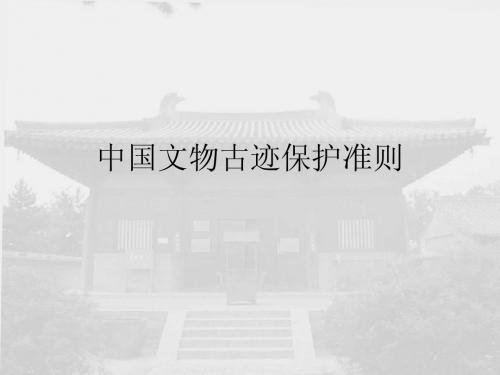
• 保护程序 第9条 文物古迹的保护工作总体上分为 六步,依次是文物调查、评估、确定各级 保护单位、制订保护规划、实施保护规划、 定期检查规划。原则上所有文物古迹保护 工作都应当按照此程序进行。
• 第三章 保 护 原 则 第18条 必须原址保护。只有在发生不可 抗拒的自然灾害或因国家重大建设工程的 需要,使迁移保护成为唯一有效的手段时, 才可以原状迁移,易地保护。易地保护要 依法报批,在获得批准后方可实施。
檐檩加设椽腕, 檐檩加设椽腕,保持举折不变 加大挑檐檩截面, 加大挑檐檩截面,但小替木,减小挑檐檩跨度,替木穿过挑 尖梁
保留原有构件,腐朽严重、不可使用的按原规格替换。 保留原有构件,腐朽严重、不可使用的按原规格替换。 在原有构件上加设构件,增大截面高度,解决结构问题, 在原有构件上加设构件,增大截面高度,解决结构问题, 且保证外观不变。 且保证外观不变。
• 第4条 文物古迹应当得到合理的利用。利用必须 坚持以社会效益为准则,不应当为了当前利用的 需要而损害文物古迹的价值。 第5条 保护必须按程序进行。所有程序都应符 合相关的法律规定和专业规则,并且广泛征求社 会有关方面的意见。其中,对文物古迹价值的评 估应当置于首要的位置。 第6条 研究应当贯穿在保护工作全过程,所有 保护程序都要以研究的成果为依据。
复原的依据来自几个方面: ①原建筑的实物遗存 这是最直接的依据。如建筑的遗址、残存的墙垣、柱础 和留下的砖瓦木石……等等构件。 ②测绘图纸和照片 有些重要古建筑在近代曾经有专家学者或旅行家摄影师 们进行科学的测绘和摄影,这类资料虽然不是直接的实物 依据,但其科学性强,是进行复原重建的可靠依据。 ③文字记述和图画 我国古代对一处重要的文物古迹、名胜或古建筑常常 有生动详细的文字或图画形象,有些建筑还有具体的尺寸, 是进行复原的重要参考。但这些资料要做认真的分析研究, 特别是诗词歌赋和写意画、文人画之类往往有艺术加工的 成分。和写意画、文人画之类往往有艺术加工的成分。要 经过科学的分析比较。
中国文物古迹保护准则(正文)
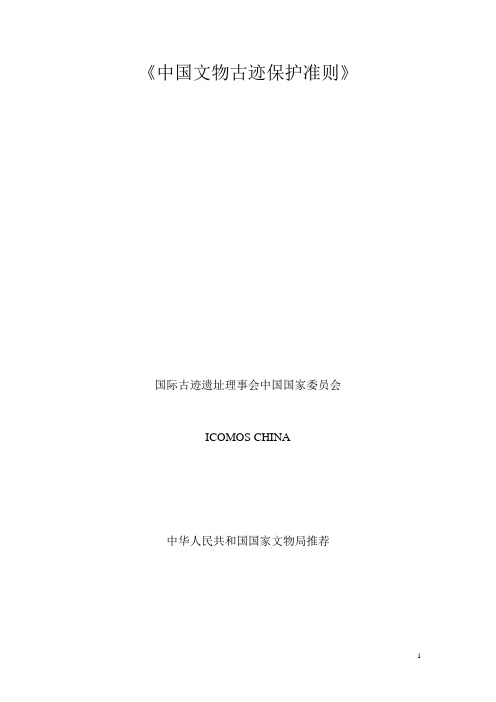
《中国文物古迹保护准则》国际古迹遗址理事会中国国家委员会ICOMOS CHINA中华人民共和国国家文物局推荐中国文物古迹保护准则序言中国是世界上地域辽阔,历史悠久,文化传统不曾中断的多民族统一国家。
遗存至今的大量文物古迹,形象地记载着中华民族形成发展的进程,他们不但是认识历史的证据,也是增强民族凝聚力,促进民族文化可持续发展的基础。
和平与发展已成为当代社会的主题。
通过对彼此文物古迹的认识,可以促进各个国家、地区间的交流,有利于保持世界和平,共同发展。
中国优秀的文物古迹,不但是中国各族人民的,也是全人类共同的财富;不但属于今天,更属于未来。
因此,将他们真实、完整地留传下去,是我们现在的职责。
中国近代的文物保护观念和方法开始于20世纪30年代。
中华人民共和国成立以后,在有效保护了一大批濒于毁坏的古迹的同时,形成了符合我国国情的保护理论和指导原则,并由国家颁布了《中华人民共和国文物保护法》和相关的法规。
在此基础上,参照以1964年《国际古迹保护与修复宪章》(《威尼斯宪章》)为代表的国际原则,特制定本《准则》。
它是在中国文物保护法的体系框架下,对文物古迹保护工作进行指导的行业规则和评价工作成果的主要标准,也是对保护法规相关条款的专业性阐释,同时可以作为处理有关文物古迹事务时的专业依据。
第一章总则第一条本准则适用的对象通称为文物古迹。
它是人类在历史上创造或人类活动遗留的具有价值的不可移动的实物遗存,包括地面与地下的古文化遗址、古墓葬、古建筑、石窟寺、石刻、近现代史迹及纪念建筑、由国家公布应于保护的历史文化街区(村镇),以及其中原有的附属文物。
第二条本准则的宗旨是对文物古迹实行有效的保护。
保护是指为保存文物古迹实物遗存及其历史环境进行的全部活动。
保护的目的是真实、全面地保存并延续其历史信息及全部价值。
保护的任务是通过技术的和管理的措施,修缮自然力和人为造成的损伤,制止新的破坏。
所有保护措施都必须遵守不改变文物原状的原则。
中国文物古迹保护准则阐释中英文对照

区域具有标志性的建(构)筑物。近、当代 made or are a combination of made and natural 工业遗产对当地社会、文化发展可能产生重 engineering and technology and have cultural 要的影响,是地方富有特色的文化载体。工 significance. Heritage canals may have attributes 业遗产的建筑、景观环境、重要设备及产品 associated with cultural landscapes and may also 是文物古迹的组成部分。 许多文物古迹类型,如:历史文化 名城、名镇、名村、文化景观等都可能与传 统生产、生活方式、信仰等非物质文化遗产 相关,这些非物质文化遗产是文物古迹价值 的重要载体,呈现出“活态”的特征。在对 文物古迹进行保护的同时也必须考虑对非物 质文化遗产的保护,考虑对当代生活的延续 所导致的文物古迹变化的有效管理。文物古 迹所在社区的参与,是这类文物古迹保护的 基础。
这一历史阶段的见证。一些工业遗产是周围 Heritage canals are aterways that are human2
《中国准则》修订版阐释部分 Commentary Revision (2014/3/25)
中文
English elements that demonstrate advances in
English existing physical remains. Documentary records may be used to provide supporting evidence to authenticate the date of a site but should not be used as the main basis for determining age. A site with components or fabric from different periods requires an explanation of the dates. When it is not possible to accurately date a site, it is permissible to describe it as dating from the beginning, middle, or end of a particularly century or dynasty. The name of a heritage site may be the original
保护文化遗产英语作文

保护文化遗产英语作文英文回答:Cultural heritage plays a pivotal role in the development and preservation of our shared human history, providing a lens through which we understand our past, present, and future. It encompasses tangible and intangible manifestations of our collective experiences, including monuments, artifacts, traditions, languages, and beliefs. Protecting cultural heritage is of paramount importance for several reasons:Preserving our past: Cultural heritage serves as a repository of our collective memory, connecting us to the past and honoring the legacy of those who came before us. It provides invaluable insights into our roots, traditions, and values, fostering a sense of identity and belonging.Inspiring present generations: Cultural heritage can ignite creativity, stimulate imagination, and inspireinnovation. By preserving and showcasing our heritage, we create opportunities for present generations to appreciate its beauty, explore its significance, and draw inspiration from its wisdom.Promoting cultural diversity: Cultural heritage highlights the richness and diversity of human expression, fostering tolerance, understanding, and respect among different cultures. It celebrates the unique contributions of each civilization and promotes a harmonious global community.Economic benefits: Cultural heritage can also contribute to economic development through tourism,cultural industries, and creative entrepreneurship. Preserving and promoting our heritage can attract visitors, generate revenue, and support local communities.Sustainable development: Cultural heritage can play a vital role in sustainable development by safeguarding traditional knowledge, practices, and ecosystems. By preserving the cultural heritage of indigenous communities,for example, we can protect valuable knowledge about biodiversity, climate adaptation, and sustainable resource management.To effectively protect cultural heritage, various measures are necessary:Legal protection: Establishing strong laws and regulations to prevent the destruction, theft, or illegal trafficking of cultural artifacts and properties.Documentation and inventory: Conducting comprehensive documentation and inventories to create a record of our cultural heritage, ensuring its accessibility and preservation for future generations.Restoration and conservation: Implementing proactive measures to restore and conserve cultural heritage sites and artifacts, using appropriate techniques and materials to maintain their integrity and longevity.Education and awareness: Raising awareness about theimportance of cultural heritage through education, outreach programs, and public campaigns, fostering appreciation and respect for our shared history.International cooperation: Collaborating with other countries and organizations to combat illicit trafficking, promote cultural exchange, and support the preservation of shared heritage.中文回答:保护文化遗产。
中国文物古迹保护准则

Page 16
2.历史街区----历史文化街区 2.历史街区----历史文化街区 历史街区---《保护条例》中规定,“历史文化街区,是 保护条例》中规定, 历史文化街区, 指经省、自治区、 指经省、自治区、直辖市人民政府核定公布的保 村文物特别丰富、历史建筑集中成片、 村文物特别丰富、历史建筑集中成片、能够较完 整和真实地体现传统格局和历史风貌, 整和真实地体现传统格局和历史风貌,并具有一 定规模的区域。 定规模的区域。”
Page 15
随着文物古迹保护范围的扩大,在这个层次上 产生了一些新的保护概念,如乡土建筑、工业建筑、 近现代建筑、大遗址等,对它们的保护与利用不能 用同一种方法。乡土建筑要继续住人,工业建筑做 点改动可以有多种用途,大遗址的保护涉及移民安 置、考古发掘,还要作公园参观,问题十分复杂。 这些还需要对《文物保护法》中“文物保护单位” 的保护方法继续加以改进和深化。 可以设想在保护历史信息真实完整的原则下, 采取分层次、分类型的区别对待的方法。
Page 7
2003年UNESCO通过,2006年开始《保护非物质 文化遗产国际公约》 2005年10月“国际古迹遗址理事会”通过 《西安宣言》 2008年10月“国际古迹遗址理事会” 通过 《文化线路宪章》
Page 8
古迹不仅包括单个建筑,还包括它们处 的环境,一般不得迁移。 修复要以历史真实和可靠文献为依据, 修补要和整体和谐又要有所区别,不可以假 乱真。 要保护古迹在各个时期的跌加物。 对遗址要保护其完整性,用正确的方式 清理开放而不应重建。
Page 22
四、文物保护规划与准则
保护规划在准则提出的中国文物古迹保护工作 程序中的地位; 准则提出的工作程序在规划中的运用; 准则提出的保护原则的运用。
中国文物古迹保护准则释义

《中国文物古迹保护准则》释义前言本题目要涉及我国和国际一些文化遗产保护领域的文献,为了简化文字,先把它们的标题、发表年代和我对它们的简称罗列于下:《国际古迹保护与修复宪章》,1964,简称《威尼斯宪章》。
《保护世界文化与自然遗产公约》,1972年在巴黎通过,1985年中国第六届全国人大第十三次常务委员会批准,简称《公约》。
《保护历史村镇与城区宪章》,1987,简称《华盛顿宪章》。
《关于真实性的奈良文件》,1994,简称《奈良文件》。
《古迹、建筑群及遗址记录工作原则》,1996年。
《中国文物古迹保护准则》,2000,简称《准则》。
《关于中国文物古迹保护准则若干重要问题的阐述》,2000,简称《阐述》。
《中华人民共和国文物保护法》,2002,简称《中国文物法》。
《文物保护工程管理办法》,2003,简称《工程管理办法》。
《中国文物古迹保护准则案例阐释》,2005,简称《案例》。
《实施保护世界文化与自然遗产公约业务指南》,2005年版,简称《实施公约指南》。
《北京文件-关于东亚地区文物建筑保护与修复》,2007,简称《北京文件》。
(《关于北京世界遗产地保护与修复的评价与建议》,《北京文件》附件,简称《评价与建议》)一、《准则》的编撰1、《准则》是以国际古迹遗址理事会中国国家委员会的名义组织编写的。
国际古迹遗址理事会(ICOMOS)是一个国际非政府专业组织,从事古迹、建筑群和考古遗址的保存、保护、修缮工作及其研究,成立于1965年。
1964年,其前身发布了《国际古迹保护与修复宪章》即《威尼斯宪章》,成为该组织共同遵守的主要思想原则。
由于该组织在专业上的重大国际影响,1972年联合国教科文组织认定其为世界遗产委员会的咨询机构。
该组织成员有建筑师、工程师、城镇规划师、考古学家、地理学家、历史学家、经济学家、文物保护工作者、遗产地的管理者等等。
根据理事会章程的规定,中国于1993年以“中国国家委员会”的名义参加了该组织。
2024《中国文物古迹保护准则》中文简版

2024《中国文物古迹保护准则》中文简版《中国文物古迹保护准则》
第一章总则
第二条本准则适用于境内的文物古迹保护工作。
第三条本准则所称“文物古迹”,是指社会发展过程中,具有重大历史、文化、科学价值的古代遗迹、建筑、石刻、书法碑帖、壁画、宗教、考古文物、群众文化遗产及其他古迹。
第二章类别分类
第四条文物古迹根据其历史价值和保护水平分为国家重点文物古迹、省级文物古迹、县级文物古迹和其他文物古迹四类。
第五条国家重点文物古迹是指具有重大历史、文化和科学价值的文物古迹,其保护要按照有关法律、法规、规章和政策,采取最严格的保护措施,力争使文物古迹完整地传承下去。
第六条省级文物古迹是指具有重大历史、文化、科学价值的国家重点文物古迹之外的文物古迹。
第七条县级文物古迹是指县域内具有一定历史、文化、科学价值的文物古迹。
第八条其他文物古迹是指县级文物古迹之外的文物古迹。
第三章保护内容
第九条对国家重点文物古迹要进行全程保护,加强保护、保护范围,建立国家级保护体系。
第十条对省级文物古迹要加强围垦保护。
中国文物古迹保护准则
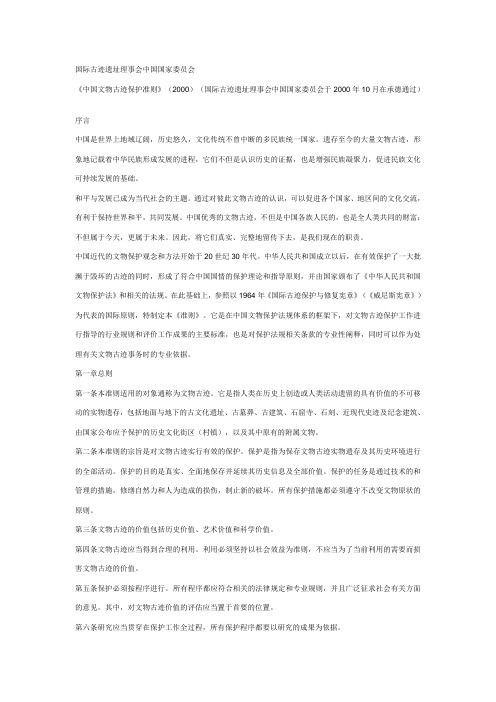
国际古迹遗址理事会中国国家委员会《中国文物古迹保护准则》(2000)(国际古迹遗址理事会中国国家委员会于2000年10月在承德通过)序言中国是世界上地域辽阔,历史悠久,文化传统不曾中断的多民族统一国家。
遗存至今的大量文物古迹,形象地记载着中华民族形成发展的进程,它们不但是认识历史的证据,也是增强民族凝聚力,促进民族文化可持续发展的基础。
和平与发展已成为当代社会的主题。
通过对彼此文物古迹的认识,可以促进各个国家、地区间的文化交流,有利于保持世界和平,共同发展。
中国优秀的文物古迹,不但是中国各族人民的,也是全人类共同的财富;不但属于今天,更属于未来。
因此,将它们真实、完整地留传下去,是我们现在的职责。
中国近代的文物保护观念和方法开始于20世纪30年代。
中华人民共和国成立以后,在有效保护了一大批濒于毁坏的古迹的同时,形成了符合中国国情的保护理论和指导原则,并由国家颁布了《中华人民共和国文物保护法》和相关的法规。
在此基础上,参照以1964年《国际古迹保护与修复宪章》(《威尼斯宪章》)为代表的国际原则,特制定本《准则》。
它是在中国文物保护法规体系的框架下,对文物古迹保护工作进行指导的行业规则和评价工作成果的主要标准,也是对保护法规相关条款的专业性阐释,同时可以作为处理有关文物古迹事务时的专业依据。
第一章总则第一条本准则适用的对象通称为文物古迹。
它是指人类在历史上创造或人类活动遗留的具有价值的不可移动的实物遗存,包括地面与地下的古文化遗址、古墓葬、古建筑、石窟寺、石刻、近现代史迹及纪念建筑、由国家公布应予保护的历史文化街区(村镇),以及其中原有的附属文物。
第二条本准则的宗旨是对文物古迹实行有效的保护。
保护是指为保存文物古迹实物遗存及其历史环境进行的全部活动。
保护的目的是真实、全面地保存并延续其历史信息及全部价值。
保护的任务是通过技术的和管理的措施,修缮自然力和人为造成的损伤,制止新的破坏。
所有保护措施都必须遵守不改变文物原状的原则。
2023-2024学年江苏省南京市玄武区八年级上学期期末语文试题

2023-2024学年江苏省南京市玄武区八年级上学期期末语文试题1. 小玄分享词语积累心得,有误的一项是()A.“要留心多音字的读音,如兴.(xìng)味、记载.(zǎi)、纤.(qiān)维等。
”B.“根据词义识记字形很好用,如‘慷慨’可释义为情绪激昂,所以是竖心旁。
”C.“形声字可根据形旁理解意思,如‘蹒跚’是足字旁,指腿脚不灵便,走路摇摆。
”D.“可根据词义辨析形近字,如‘蔓’指缠绕的植物枝茎,而‘幔’则表示帷幕。
”2. 复习句子的语气时,小组进行了如下讨论,其中理解有误的一项是()A.“苏州园林是我国各地园林的标本。
”这是陈述句,陈述客观事实。
B.“难道你就觉得它只是树?”这是疑问句,表示反问语气。
C.“让我们赞美那毁灭不掉的生命吧!”这是祈使句,表示命令语气。
D.“唉,我不知何时再能与他相见!”这是感叹句,表达思念之情。
3. 小玄为小武讲解下面句子的成分,其中分析有误的一项是()张择端的《清明上河图》可以说是北宋风俗画中最具代表性的杰作。
A.“张择端的”修饰“《清明上河图》”,为定语。
B.句子中“可以说”修饰“是”,是状语。
C.“北宋风俗画中”位于“是”之后,是补语。
D.这个句子的主干为“《清明上河图》是杰作”。
4. 在复习《我们的互联网时代》综合性学习时,小组围绕网络词语展开了讨论。
你依据讨论内容,向大家简要介绍网络词语受欢迎的原因。
小武:“3Q是英语thank you的谐音,简洁有新意,很多网络词语都是这样。
”小贝:“我觉得在日常生活中使用网络词语无伤大雅,但在写作文时要慎用。
”小玄:“工具书也会收录网络词语,可见网络词语也有可能成为规范汉语的一部分。
”小熙:“‘特种兵旅游’‘挖呀挖呀挖’这些网络词语能紧跟社会热点,非常时髦。
”5. 小组分类梳理了诗词意象,根据提示填写诗句。
【意象•鸟】“山气日夕佳,(1)__________”(陶渊明《饮酒(其五)》)中的“鸟”流露出诗人归隐的闲适,“感时花溅泪,(2)__________”(杜甫《春望》)中的“鸟”传达出诗人忧国伤时的悲叹,“(3)____________”(李清照《渔家傲》)中的鸟寄寓着诗人对美好理想的追求。
中国文物古迹保护准则案例阐释2

对保护处理后的壁画进行数码摄影记录; 悵 誘 执行保护处理后状况的监控计划,包含对选中的监控区域进行定期检查; 执行维护计划。 羲 溫 統 夤 持续环境监测以研究游客对洞窟状况的影响,并开展对窟门封闭系统的评 估; 评估参观者对85窟展示、说明的反响。 笝惆豢摯砐醴杅擂湔紫 蚳模巹埜頗勤砐醴輛俴机
30
菴 9 沭 | 菴媼梒 悵誘最唗
• 酗軞醴梓 集合了保护、研究和教育方 面的核心使命。 • 埻寀 确定保护莫高窟价值的最适当的方 式并作为未来保护和发展的指导。莫高 窟保护中尤其重要的原则包括保持真实 性和完整性的总原则,执行原则包括最 小干预和不改变历史原状及只使用经实 验证明有效的技术。 • 煦砐醴梓 按照保护、利用、研究和管理 几方面分项陈述了依照总目标和原则, 为保护莫高窟价值而需要采取的工作: -保护分项目标不仅涉及洞窟,还涉及 背景环境和自然环境,遗址地的维 护需要,以及提高保护工作质量、 科学水平和技术能力。 -利用目标的一个重点是改善游客体验 的质量和多样性,同时对游客过多 造成的不利影响进行管理,并与旅 游部门合作。 -研究目标作为单独标题列出是因为自 敦煌研究院建立以来敦煌研究的重 要。 -管理目标对象涉及广泛,例如增强员 工积极性和专业能力,与兰州大学 合作创办壁画保护硕士学位课程, 增强国际合作,为员工生活和发展
偶瞰25
悵誘最唗悵賸悵誘馱釬腔軀 憮磁燴俶ㄛ旆躇腔軀憮徹最岆悵痐 悵誘樵習絞﹜旌轎勤祥褫婬汜腔 恅昜嘉慫婖傖拸楊侺隙腔囷漲腔笭 猁價插﹝
蘆詢貓悵誘寞赫最唗
2003年敦煌研究院联合有资质的规划 设计部门,完成了总体规划,并使其与国 保单位保护规划要求相一致。制定保护规 划的程序如下: 1. 覃脤 《准则》中叙述的规划过程以调查和 对遗址地及其组成的认定作为开始。 虽然在莫高窟这一调查已经进行了 50余年,但规划的过程提供了新的机会, 可以吸收和综合艺术、历史、地质学和环 境方面等现存信息,进行新的测绘,更好 的记录文物资源,并认识到对遗址地了解 的欠缺。这一过程的成果如:对所有石窟 的最新数字照相和状况调查,对岩面的新 摄影测量,以及对档案记录的更好组织、 综合。 2. 歎硉﹜悵湔珋袨睿奪燴沭璃嘛 评估是保护规划程序中的关键。遗址
文物保护工程师 勘察设计和规划通论 模拟试题及答案

模拟试题判断题1.我国古代建筑在唐、宋及元建筑在脊槫两端置生头木,正脊起翘比较生动;明清时屋脊延续了这一特点。
A.对B.错2.洋务运动后,近代中国的新建筑体系已经形成,主要表现在:居住建筑、公共建筑、工业建筑的主要类型已大体齐备,水泥、玻璃、机制砖瓦等新建筑材料生产能力有了明显发展,施工技术和工程结构也有较大提高。
A.对B.错3.《营造法式》中将材分为九等。
A.对B.错4.《工部工程做法》是梁思成先生所著。
A.对B.错5.清代官式建筑营建以斗口为模数。
A.对B.错6.方志的发展从它的形态特点看,可分为地记、图经和方志三个阶段。
A.对B.错《方志学通论》7.隋、唐至北宋,志书的主要形式是舆图和说明文字相结合的图经或图记。
A.对B.错8.在南北朝石窟艺术中,壁画重点题材是本生故事,从唐代开始,逐渐流行经变题材。
A.对B.错9.考古学是根据古代人类活动遗留下来的实物来研究人类情况的一门科学。
A.对B.错10.地层学和类型学对于考古研究来说,互相依赖,缺一不可。
在地层学与类型学的关系中,类型学具有决定性意义。
A.对B.错11.隋唐长安城的规划深刻地影响了日本平安城及平城京,以及渤海国东京城的规划。
A.对B.错12.摄影测量是利用光学摄影机或数码摄影机获取的像片,经过处理以获取被摄物体的形状、大小、位置、特性及其相互关系的一种测量方法。
A.对B.错13.《既有建筑地基基础结构加固技术规范》中规定:地基分析评价应包括以下内容:地基承载力地基变形的评价;引起既有建筑开裂差异沉降、倾斜等的原因;地基加固的必要性,提出加固方法的建议;提出地基加固设计所需的有关参数。
A.对B.错14.根据《古建筑消防管理规则》,凡与文物建筑毗连的其他房屋,应有防火隔墙或开辟消防通道。
文物建筑保护区的通道、出入口必须保持畅通,不得堵塞和侵占。
A.对B.错15.根据《文物系统博物馆风险等级和安全防护级别的规定》,防护级别的确定原则上与风险等级相对应。
郑军-中国文物古迹保护准则
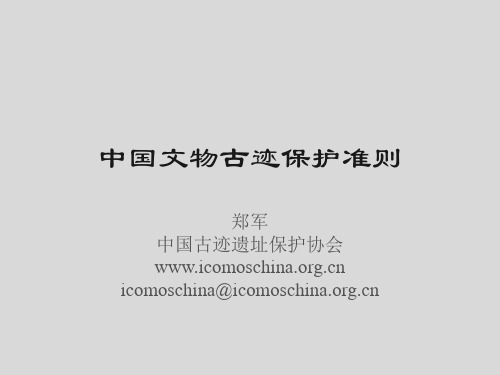
文化景观
文化线路
正文
第一章:总则(1-8) 第二章:保护原则(9-15) 第三章:保护和管理程序(16-23) 第四章:保护措施(24-39) 第五章:合理利用(40-45) 第六章:附则(46-47)
第一章:总则
第1条:适用对象 第2条:宗旨 第3条:价值 第4条:程序 第5条:研究 第6条:利用 第7条:从业人员要求 第8条:广泛参与
遗产运河:大运河
科技遗产:登封天地之中
红山指挥部
工业遗产:上海杨树浦自来水厂
第2条:宗旨
• 准则的宗旨是对文物古迹实施有效保护。 保护是指为保存文物古迹及其环境存其 历史信息及其价值。
City of Suyab (Site of Ak-Beshim)
City of Nevaket (Site of Krasnaya Rechka)
哈国申报遗产点
Site of Kostobe Site of Aktobe
Site of Ornek
Site of Karamergen Site of Akyrtas
Xingjiao Temple Tower
Site of Ancient Chang‘an City of Han Dynasty, Site of Jiaofang Hall, Weiyang Palace
Qian Imperial Mausoleum
吉国申报遗产点
中国文物保护准则

张柏:中国文物古迹保护准则与城市文化各位代表,大家好!城市文化的提法由来已久,但真正将其作为一个严肃的命题而进行深入探讨,却是近年来的事情。
随着经济全球化进程的加快,文化在城市发展中的作用引起了越来越广泛的重视。
经济发展可以随着国际形势的风云变幻而实时转型,文化发展却由于其坚韧的历史根系而能够相对较好的保存其原有的精髓。
这也正是在世界范围内提倡保护文化多样性的一个客观基础。
从某种角度上说,一个城市的形成本身便是一种区域文化的凝缩.体现了当地早期的人类群体对自然环境的适应和利用的原则,在物质上反映在建筑、交通、饮食、服饰等方面,在精神上则反映在风俗、观念、语言、艺术等方面。
城市在诞生之初所具备的各种特征和总体风格,会在其日后的发展过程中世代传递,逐步演变,从而形成每个特定历史时期不同的城市风貌。
所谓的城市文化,从广义上说,包含了城市从有形到无形的各个方面。
它是一个具有生命力的有机体,在成长代谢中吐旧纳新,既能吸收消化外来的影响,又能牢固维系其自身的根脉,即便受到战火的重创,仍然能够顽强的恢复生机,重现繁荣昌盛。
我们今天所推崇的城市文化发展便是要充分尊重城市的历史渊源,让现代文明和谐融入城市的历史文化,而绝不是粗暴的扰乱或冲毁。
一个城市的历史文化,主要的物质载体之一便是幸存至今的各类文物古迹,这些文化遗产集中体现了历史上城市的缔造者和传承者从不同角度对于城市发展的思考和决定,进而反映了不同时代的社会人文景况和科学发展成果。
这些对于今人无疑是弥足珍贵的信息。
事实证明,全球化的经济发展会带动世界各个角落的协同运作,如果不及时的,有意识的留住城市重要的历史标记,那么这些脆弱的文化遗产将很快消失殆尽,千城一面的状况会不可避免的呈现在世人眼前,那时我们再谈论城市文化必然会力不从心,并且也将最终失去意义。
城市文化的一个重要体现,是人们如何看待自身所生活的这个城市的历史,是否对其给予足够的重视,是否在追求现代化生活方式所带来的舒适和便利的同时,还能积极主动的为文化遗产的继续存在提供足够的空间和长期的人、财、物力的支持。
中国文物保护的英文文件
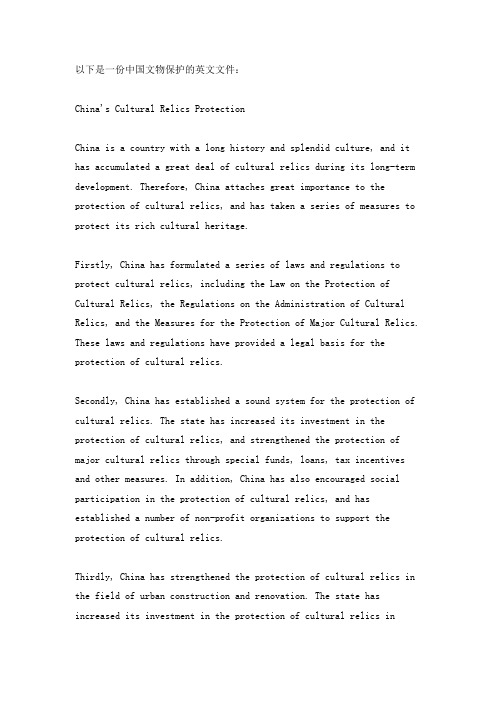
以下是一份中国文物保护的英文文件:China's Cultural Relics ProtectionChina is a country with a long history and splendid culture, and it has accumulated a great deal of cultural relics during its long-term development. Therefore, China attaches great importance to the protection of cultural relics, and has taken a series of measures to protect its rich cultural heritage.Firstly, China has formulated a series of laws and regulations to protect cultural relics, including the Law on the Protection of Cultural Relics, the Regulations on the Administration of Cultural Relics, and the Measures for the Protection of Major Cultural Relics. These laws and regulations have provided a legal basis for the protection of cultural relics.Secondly, China has established a sound system for the protection of cultural relics. The state has increased its investment in the protection of cultural relics, and strengthened the protection of major cultural relics through special funds, loans, tax incentives and other measures. In addition, China has also encouraged social participation in the protection of cultural relics, and has established a number of non-profit organizations to support the protection of cultural relics.Thirdly, China has strengthened the protection of cultural relics in the field of urban construction and renovation. The state has increased its investment in the protection of cultural relics inurban construction and renovation, and will not carry out demolition or destruction of buildings with historical value or cultural value. At the same time, China will also actively guide and encourage citizens to participate in the protection of cultural relics through publicity and education activities.Finally, China will also strengthen cooperation with other countries in the field of cultural relic protection. China will actively promote cooperation with other countries in the field of cultural relic protection through international exchanges and cooperation, and will share experience and information with other countries to jointly protect the world's cultural heritage.In conclusion, China has taken a series of measures to protect its rich cultural heritage, including formulating laws and regulations, establishing a sound system for the protection of cultural relics, strengthening the protection of cultural relics in the field of urban construction and renovation, and strengthening cooperation with other countries in the field of cultural relic protection. This will help to promote the protection of China's rich cultural heritage and promote its long-term development.。
保护文物作文英文翻译
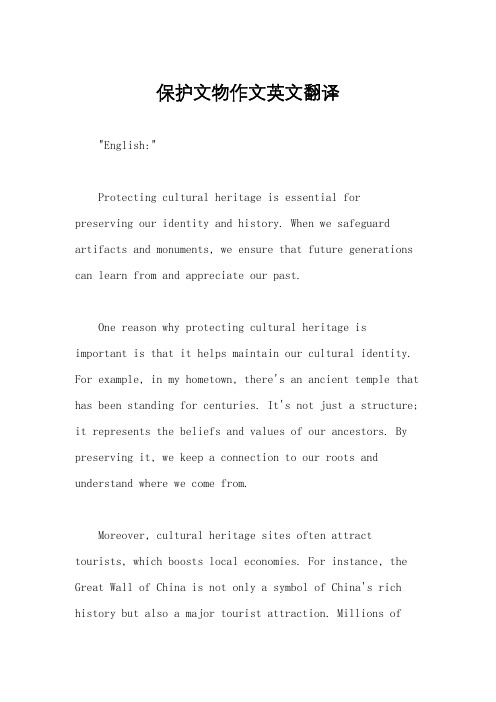
保护文物作文英文翻译"English:"Protecting cultural heritage is essential for preserving our identity and history. When we safeguard artifacts and monuments, we ensure that future generations can learn from and appreciate our past.One reason why protecting cultural heritage is important is that it helps maintain our cultural identity. For example, in my hometown, there's an ancient temple that has been standing for centuries. It's not just a structure; it represents the beliefs and values of our ancestors. By preserving it, we keep a connection to our roots and understand where we come from.Moreover, cultural heritage sites often attract tourists, which boosts local economies. For instance, the Great Wall of China is not only a symbol of China's rich history but also a major tourist attraction. Millions ofpeople visit it every year, contributing to the economy through tourism revenue and job opportunities.Additionally, protecting cultural heritage fosters a sense of pride and belonging among communities. Take, for instance, traditional festivals. In my culture, we have a festival where people gather to celebrate our heritage through music, dance, and food. When we protect thetraditions associated with these festivals, we strengthen the bonds within our community and create a shared sense of identity.In summary, protecting cultural heritage is vital for preserving our identity, boosting local economies, and fostering community cohesion. By safeguarding our artifacts and monuments, we not only honor our past but also enrich our present and future."中文,"保护文物是至关重要的,因为这样可以保护我们的身份和历史。
保护文化遗址的英语作文结尾
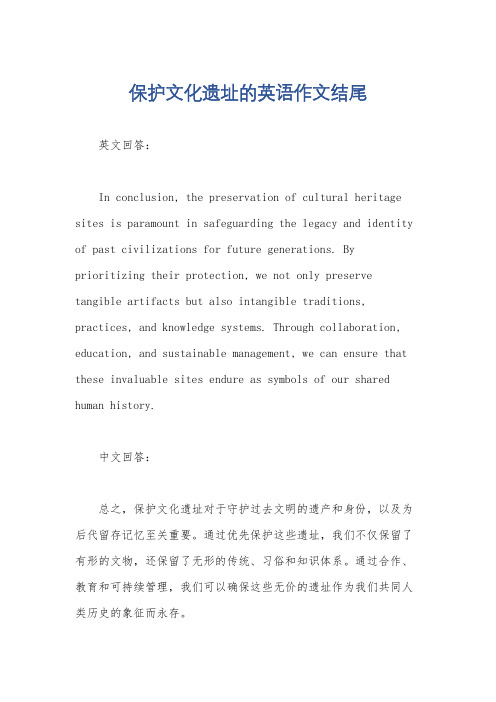
保护文化遗址的英语作文结尾英文回答:
In conclusion, the preservation of cultural heritage sites is paramount in safeguarding the legacy and identity of past civilizations for future generations. By prioritizing their protection, we not only preserve tangible artifacts but also intangible traditions, practices, and knowledge systems. Through collaboration, education, and sustainable management, we can ensure that these invaluable sites endure as symbols of our shared human history.
中文回答:
总之,保护文化遗址对于守护过去文明的遗产和身份,以及为后代留存记忆至关重要。
通过优先保护这些遗址,我们不仅保留了有形的文物,还保留了无形的传统、习俗和知识体系。
通过合作、教育和可持续管理,我们可以确保这些无价的遗址作为我们共同人类历史的象征而永存。
保护文化遗产倡议信英语作文
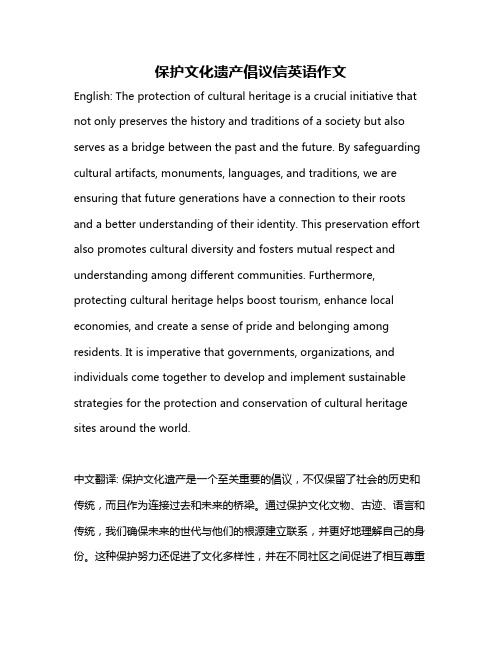
保护文化遗产倡议信英语作文English: The protection of cultural heritage is a crucial initiative that not only preserves the history and traditions of a society but also serves as a bridge between the past and the future. By safeguarding cultural artifacts, monuments, languages, and traditions, we are ensuring that future generations have a connection to their roots and a better understanding of their identity. This preservation effort also promotes cultural diversity and fosters mutual respect and understanding among different communities. Furthermore, protecting cultural heritage helps boost tourism, enhance local economies, and create a sense of pride and belonging among residents. It is imperative that governments, organizations, and individuals come together to develop and implement sustainable strategies for the protection and conservation of cultural heritage sites around the world.中文翻译: 保护文化遗产是一个至关重要的倡议,不仅保留了社会的历史和传统,而且作为连接过去和未来的桥梁。
(中英文对照版)保护世界文化和自然遗产公约
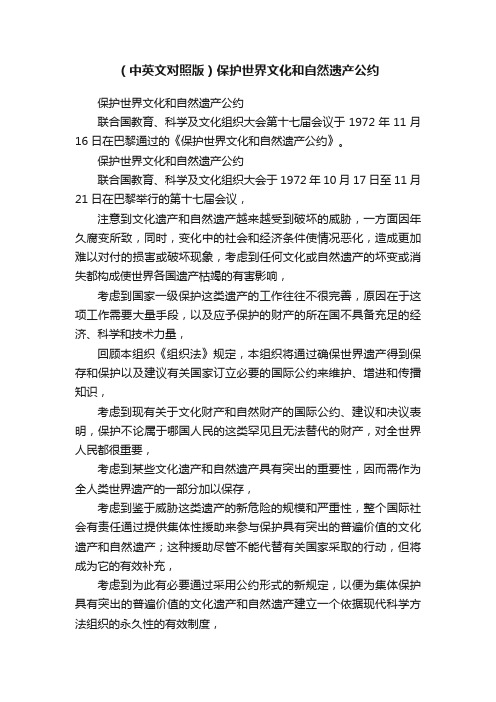
(中英文对照版)保护世界文化和自然遗产公约保护世界文化和自然遗产公约联合国教育、科学及文化组织大会第十七届会议于1972年11月16日在巴黎通过的《保护世界文化和自然遗产公约》。
保护世界文化和自然遗产公约联合国教育、科学及文化组织大会于1972年10月17日至11月21日在巴黎举行的第十七届会议,注意到文化遗产和自然遗产越来越受到破坏的威胁,一方面因年久腐变所致,同时,变化中的社会和经济条件使情况恶化,造成更加难以对付的损害或破坏现象,考虑到任何文化或自然遗产的坏变或消失都构成使世界各国遗产枯竭的有害影响,考虑到国家一级保护这类遗产的工作往往不很完善,原因在于这项工作需要大量手段,以及应予保护的财产的所在国不具备充足的经济、科学和技术力量,回顾本组织《组织法》规定,本组织将通过确保世界遗产得到保存和保护以及建议有关国家订立必要的国际公约来维护、增进和传播知识,考虑到现有关于文化财产和自然财产的国际公约、建议和决议表明,保护不论属于哪国人民的这类罕见且无法替代的财产,对全世界人民都很重要,考虑到某些文化遗产和自然遗产具有突出的重要性,因而需作为全人类世界遗产的一部分加以保存,考虑到鉴于威胁这类遗产的新危险的规模和严重性,整个国际社会有责任通过提供集体性援助来参与保护具有突出的普遍价值的文化遗产和自然遗产;这种援助尽管不能代替有关国家采取的行动,但将成为它的有效补充,考虑到为此有必要通过采用公约形式的新规定,以便为集体保护具有突出的普遍价值的文化遗产和自然遗产建立一个依据现代科学方法组织的永久性的有效制度,在大会第十六届会议上曾决定就此问题制订一项国际公约,于1972年11月16日通过本公约。
Ⅰ、文化遗产和自然遗产的定义第一条为实现本公约的宗旨,下列各项应列为“文化遗产”:古迹:从历史、艺术或科学角度看具有突出的普遍价值的建筑物、碑雕和碑画、具有考古性质的成份或构造物、铭文、窟洞以及景观的联合体;建筑群:从历史、艺术或科学角度看在建筑式样、分布均匀或与环境景色结合方面具有突出的普遍价值的单立或连接的建筑群;遗址:从历史、审美、人种学或人类学角度看具有突出的普遍价值的人类工程或自然与人的联合工程以及包括有考古地址的区域。
- 1、下载文档前请自行甄别文档内容的完整性,平台不提供额外的编辑、内容补充、找答案等附加服务。
- 2、"仅部分预览"的文档,不可在线预览部分如存在完整性等问题,可反馈申请退款(可完整预览的文档不适用该条件!)。
- 3、如文档侵犯您的权益,请联系客服反馈,我们会尽快为您处理(人工客服工作时间:9:00-18:30)。
下遗存,或其它足以证明其为确实地点的实 vi. 物为依据。只有文献记载和口头传说,不能 vii. 成为确定地址的证据。 文物古迹的年代是指现存实物遗存的
viii. Other historic attributes of particular significance.
年代。文献记载可以印证年代的准确性,但 The location of a heritage site must be determined 不应作为判断年代的主要依据。一个组群中 by the existence of aboveground or buried 存在不同年代的单体,或一个单体中存在不 remains or other physical evidence that sufficiently 同年代的构件,应分别说明。不能判定准确 Written records or traditional oral accounts alone 的年份时,可以将年代断定在世纪的上、 are not sufficient proof of the location of a site. 中、下叶,或王朝的初、中、晚期范围内。 The age of a heritage site is established from
with the natural environment and have
Heritage routes are created by activities related to transportation, the migrations of people, trade and commerce, and the military within a specific geographic area and consist of road and water transportation networks along with their associated sites. Heritage routes demonstrate the interaction of different cultures and have promoted cultural development along transportation routes. The significance of this category of cultural heritage lies in its cultural diversity.
have been registered as a result of national survey and inventory campaigns. A heritage site must comprise of actual physical remains that have historical, locational, and period elements. Important historical elements of a heritage site include i. Significant events or activities associated with historic figures. ii. Significant undertakings in science and technology, production, transportation, and commerce. iii. iv. v. Traditional institutions. Ethnic culture and religious culture. Family and society. Literature and the arts. Folk customs and trends of a period.
It may also be a name with important commemorative significance or one that has become established through popular usage.
网或水上交通线及相关遗迹构成的,反映不 Historically and culturally famous cities, towns and 同文化相互交流,促进沿线文化发展,体现 villages also have significance as they reflect the 文化多样性价值的文物古迹类型。 遗产运河是具有文物古迹价值的人
1 demonstrates the actual location of the site.
《中国准则》修订版阐释部分 Commentary Revision (2014/3/25)
中文 文物古迹的名称,可以使用始建时的 名称,也可以使用存在时间最长的名称,还 可以使用有重要纪念意义的或在公众间约定 俗成的名称 。 历史文化名城名镇、名村反映了人 类聚落发展、演变的历史,承载了文化的多 样性,具有文物古迹价值; 文化景观是人类活动,(包括行为
history of the development and evolution of human settlement and are a medium through which cultural diversity is expressed.
工或人工与自然相结合的水路,它反映了人 Cultural landscapes are the results of landscapes 类的工程技术成就。它可能同时具有文化景 that were created through human interactions 观的特征,也可能因反映了人类通过这一水 (both physical actions and inventive processes) 路而发生的多向的文化交流,并促进了沿线 significance. 文化的发展,而具有文化线路的特征。 那些曾经发生了科学技术重大进步 的场所及附属科学研究设备等,具有见证科 学技术发展的价值,这些场所及附属设备也 是文物古迹的组成部分。 工业遗产特指能够展现工艺流程和 工业技术的具有文物古迹价值的近、当代工 业建筑遗存及设备、产品等。工业化发展是 我国近、当代历史的重要阶段,工业遗产是
和思想)与自然环境相互作用,形成的具有 name used when the site was built or the name that has been used for the longest period of time. 文物古迹价值的景观遗存; 文化线路:由于交通、迁徙、商贸 或军事活动, 在一定的地理区域内,以路
